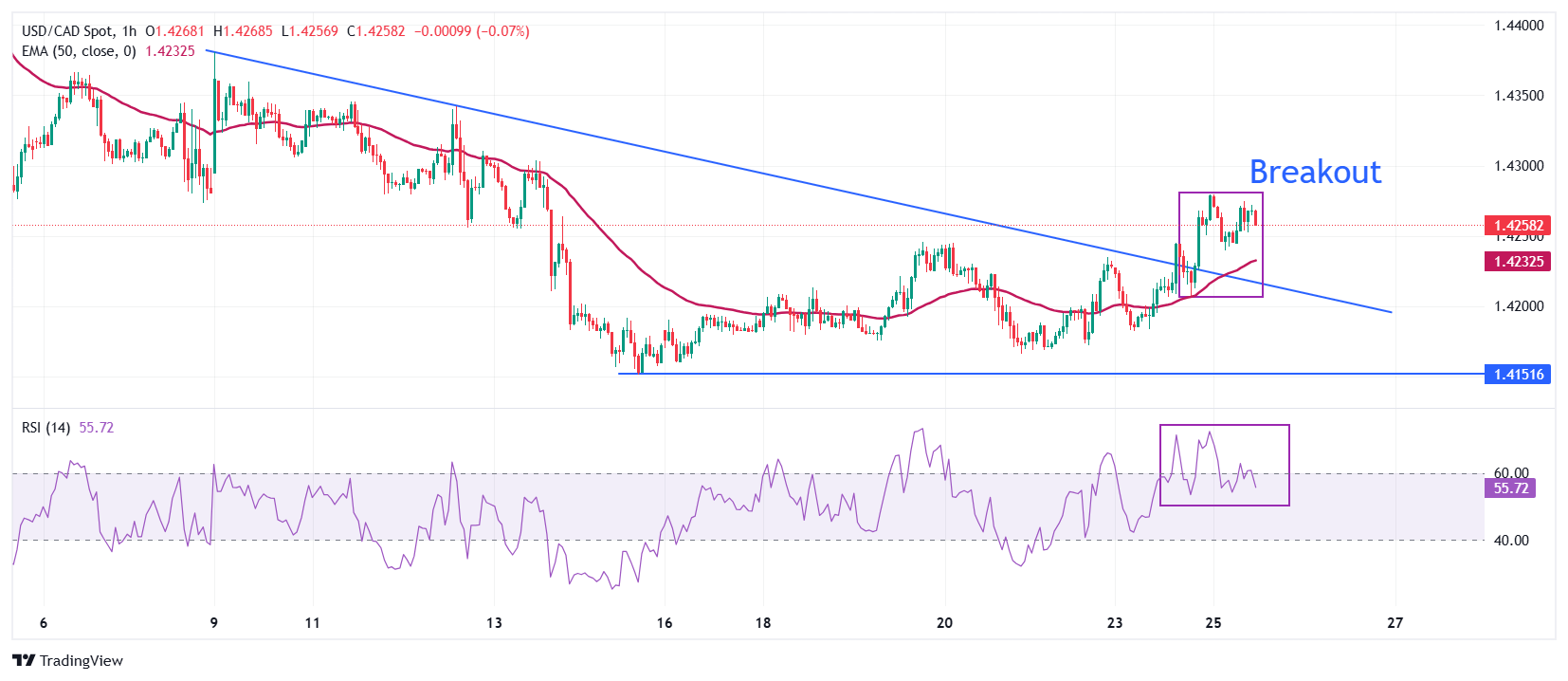- The USD/CAD clings to profits about 1,4260 amid renewed fears about Trump’s tariffs to Canada and Mexico.
- Inflation in Canada has remained below the mandate of the BOC in the last three months.
- The governor of Bock, Macklem, warned that the impact of Trump’s tariffs could be severe for Canada.
The USD/CAD clings to profits about 1,4260 at European negotiation hours on Tuesday. The Loonie’s PAR maintains the recovery movement of Monday while the US dollar (USD) stabilizes after the president of the United States (USA) confirmed that its plans to impose 25% tariffs on imports from Canada and Mexico March 4 are intact.
The US dollar index (DXY), which measures the value of the dollar against six main currencies, is slightly down but is maintained around the recovery movement of Monday about 106.70.
President Trump postponed his plans to impose 25% tariffs on Canada and Mexico on February 4 after both nations agreed to send forces to the borders to restrict the flow of fentanyl and undocumented immigrants towards the US.
Trump’s tariffs to Canada would weaken their already vulnerable economic perspective. Inflation in the Canadian economy has been below the goal of 2% of the Canada Bank (BOC) during the last three months, which suggests a weak demand environment.
On Friday, the governor of Boc, Tiff Macklem, warned in an Ontario speech that the economic impact would be severe if Trump imposes tariffs on all imports from Canada.
The USD/CAD breaks the descending triangle graphic pattern formed in a one -hour temporal frame. The descending edge of the aforementioned graphic pattern was drawn from the maximum of February 9, 1,4380 and the flat edge was placed from the minimum of February 14, 1,4151.
The exponential (EMA) mobile average of 50 periods is inclined up to 1,4230, which suggests a short -term upward trend.
The relative force index (RSI) of 14 periods is traded above 50.00, indicating that there is an upward impulse.
From now on, an upward movement above the maximum of February 24, 1,4280 will open the door towards the round level resistance of 1,4300 and the maximum of February 9, 1,4380.
On the contrary, if the pair breaks below its minimum of February 14, 1,4151, it will fall to its minimum of December 9, 1,4094, followed by its minimum of December 6, 1,4020.
USD/Cad time chart
Canadian dollar faqs
The key factors that determine the contribution of the Canadian dollar (CAD) are the level of interest rates set by the Canada Bank (BOC), the price of oil, the main export product of Canada, the health of its economy, Inflation and trade balance, which is the difference between the value of Canadian exports and that of their imports. Other factors are market confidence, that is, if investors bet on riskier assets (Risk-on) or seek safe assets (Risk-Off), being the positive risk-on CAD. As its largest commercial partner, the health of the US economy is also a key factor that influences the Canadian dollar.
The Canada Bank (BOC) exerts a significant influence on the Canadian dollar by setting the level of interest rates that banks can provide with each other. This influences the level of interest rates for everyone. The main objective of the BOC is to maintain inflation between 1% and 3% by adjusting interest rates to the loss. Relatively high interest rates are usually positive for CAD. The Bank of Canada can also use quantitative relaxation and hardening to influence credit conditions, being the first refusal for CAD and the second positive for CAD.
The price of oil is a key factor that influences the value of the Canadian dollar. Oil is the largest export in Canada, so the price of oil tends to have an immediate impact on the value of the CAD. Generally, if the price of oil rises, the CAD also rises, since the aggregate demand of the currency increases. The opposite occurs if the price of oil drops. The highest prices of oil also tend to give rise to a greater probability of a positive commercial balance, which also supports the CAD.
Although traditionally it has always been considered that inflation is a negative factor for a currency, since it reduces the value of money, the opposite has actually happened in modern times, with the relaxation of cross -border capital controls. Higher inflation usually leads to central banks to raise interest rates, which attracts more capital of world investors who are looking for a lucrative place to save their money. This increases the demand for the local currency, which in the case of Canada is the Canadian dollar.
The published macroeconomic data measure the health of the economy and can have an impact on the Canadian dollar. Indicators such as GDP, manufacturing and services PMIs, employment and consumer confidence surveys can influence the CAD direction. A strong economy is good for the Canadian dollar. Not only attracts more foreign investment, but it can encourage the Bank of Canada to raise interest rates, which translates into a stronger currency. However, if the economic data is weak, the CAD is likely to fall.
Source: Fx Street
I am Joshua Winder, a senior-level journalist and editor at World Stock Market. I specialize in covering news related to the stock market and economic trends. With more than 8 years of experience in this field, I have become an expert in financial reporting.








